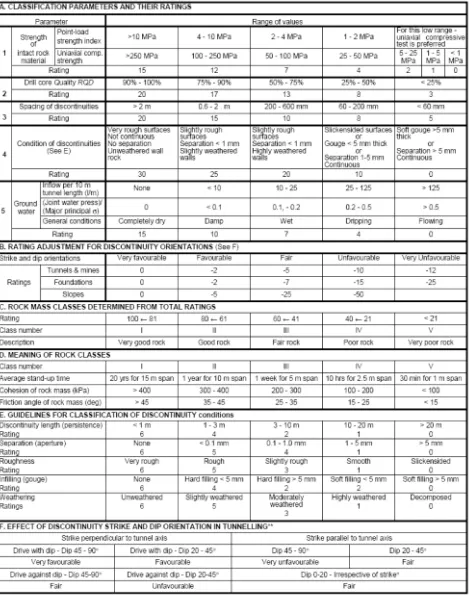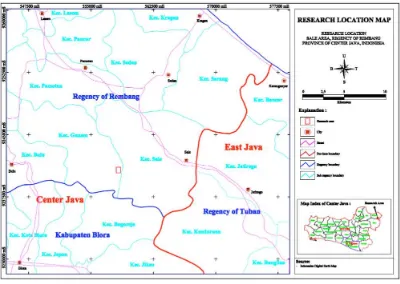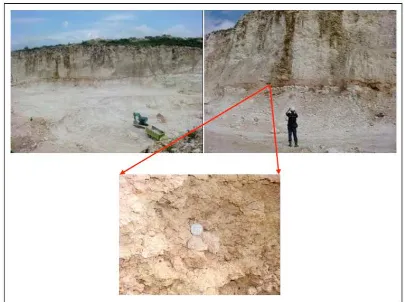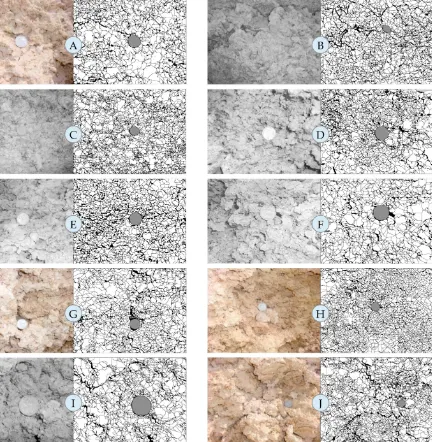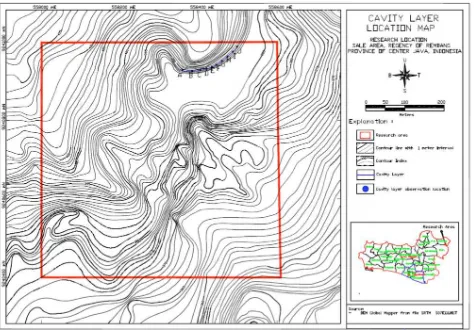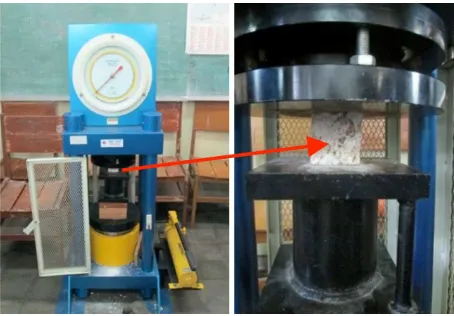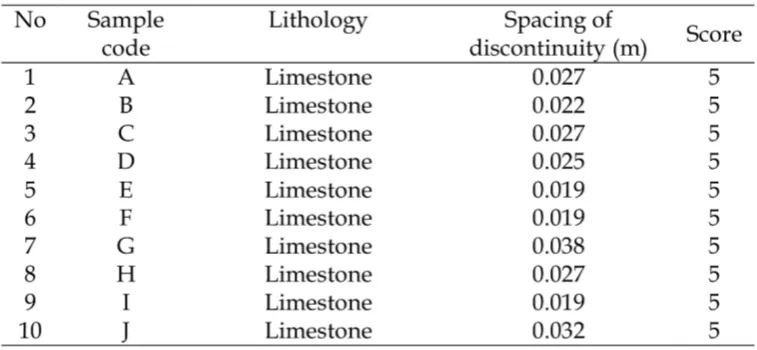LAYER IN REMBANG, CENTRAL JAVA,
INDONESIA
R. Andy Erwin Wijaya*1, Dwikorita Karnawati2, Srijono2, and Wahyu Wilopo2
1Department of Mining Engineering, Sekolah Tinggi Teknologi Nasional, Indonesia
2Department of Geological Engineering, Faculty of Engineering, Universitas Gadjah Mada, Indonesia
Abstract
Safety of a limestone mining activity requires a good mine design. Mine design is determined by the rock mass quality, which varies from one mine location to another, depending on the geological conditions. The research area is located in limestone quarry of Sale District, Rembang Regency, Central Java Province, Indonesia. In the study area, a cavity zone is exposed at the wall of quarry bench and occurs by a solution process. The cavity layer zone is a weak zone which has caused bench failures. The objective of this re-search is to evaluate the quality of the cavity lime-stone layer for a safe mine design using Rock Mass Rating (RMR) system. Final result of the research is a rock mass characterization, specifically for the cavity limestone layer.
Keywords: Rock mass rating, limestone, cavity layer
1 Introduction
Limestone mining in Sale District, Rembang Re-gency, Center Java Province-Indonesia uses the quarry method, which is one of the surface mine methods (Hustrulid and Kuchta, 1995). Reliable estimates of the strength and deforma-tion characteristics of rock masses are required for almost any form of analysis used for the mine design of surface excavations specifically for bench of limestone quarry. Rock mass
classi-*Corresponding author: R.A.E. WIJAYA, Department
of Mining Engineering, Sekolah Tinggi Teknologi Na-sional, Indonesia. E-mail: [email protected]
fication systems used to be of prime importance to estimate rock mass behavior. In 1973 Bi-eniawski was the first who developed the rock mass rating (RMR) system (CSIR known as the South African Council of Scientific and Indus-trial Resarch), and sustained its development until 1989. By the available data its versions found more than 350 applications in under-ground opening, tunnels, underunder-ground mines, and open-pit slope designs. The RMR sys-tem is used in this research to determine rock mass strength of the surface mine, particularly the limestone quarry. Some parameters are re-quired in the RMR analysis. The main param-eters are strength of intact rock, RQD, spacing of discontinuity, condition of discontinuity and groundwater (Table 1).
2 Location and site characterization
The research area is located in limestone quarry of Sale District, Rembang Regency, Central Java Province, Indonesia. The research area is bounded by coordinates: 558000 mE – 558600 mE and 9240400 mN – 9241000 mN (Figure 1).
3 Geological condition
WIJAYAet al.
Figure 1: Location of the research area (red box).
and steep hills. Based on the geological map of Jatirogo (Figure 2), the research area is cov-ered by Paciran Formation, which consists of massive limestone and dolomitic limestone (Si-tumorang, et al., 1992). The rocks in the Rem-bang Zone have undergone intensive folding and faulting resulting in anticlines and syn-clines.
4 Solution cavity layer in limestone quarry
In some parts of the limestone quarry area, there is cavity zone, which is formed by solu-tion of limestone, at the wall of quarry bench (Figure 3). The cavity zone is a potentially weak zone of bench failure. The cavity zone is from 50 to 300 cm wide and located at an elevation of approximately 389 m above sea level. The slope of quarry bench ranges from 60º to 75º. Obser-vation of limestone cavity zone was conducted at 10 location points with A to J sample names (Figure 4). Location of each outcrop observa-tion point in coordinates as follow (Table 2) and the cavity layer map (see Figure 5).
WIJAYAet al.
Figure 2: Geological map.
WIJAYAet al.
Figure 6: Uniaxial Compressive Strength (UCS) equipment.
5 RMR estimation for rock mass quality of cavity zone in limestone quarry
Identification of rock mass characteristic has been proposed to determine rock mass qual-ity. This system provides a method for esti-mating the reduction in rock mass strength for different geological conditions as identified by field observations. Classification of rock mass quality based on the RMR, combined 5 (five) main parameters, i.e. strength of intact rock, RQD, spacing of discontinuities, condition of discontinuities and groundwater. Based on out-crop observations in limestone quarry area, all structure condition of the cavity limestone layer are described by the term disintegrated as the rock masses are poorly interlocked, heavily bro-ken rock mass with a mixture or angular and rounded rock pieces (see Figure 4). Based on the uniaxial compressive strength (UCS) test, they have 8-12,4 MPa rock strength (Table 3 and Figure 6). Based on field observations, most of structure and surface conditions are very small block, rough rock surface (Table 4), moderately weathered to weathered (Table 5) and soft infill-ing material (Table 6). Condition of groundwa-ter is dry (Table 7). The scores of RMR estima-tion for rock mass strength of cavity layer zone
6 Conclusions
The cavity limestone layer in the study area consist of very small blocks with rough surface, moderately weathered to weathered and soft infilling materials. The scores of RMR estima-tion for rock mass quality of cavity layer zone in the limestone quarry are between 40 and 46, indicating a poor rock mass quality. The cav-ity layer zone is a weak zone which has caused bench failures in the limestone quarry area.
Acknowledgment
Authors would like to thank to Management of PT. Sinar Asia Fortuna for the permit and fa-cility provided during the research in the lime-stone quarry.
References
Bieniawski, Z. T. (1989) Engineering Rock Mass Classification, John Wiley dan Sons, Inc., Canada
Deere D.U. and Deere, D.W. (1967) Uniaxial Compressive Strength (UCS) after 20 years, Report manual, Contract DACW39-86-M-4273, Department of the Army, U.S. Corps of Engineers, Washington DC.
Hustrulid, W. and Kuchta, M. (1995) Open Pit Mine Planning and Design, Volume 1 Funda-mental, A.A. Balkema, Roterdam, Brookfield. Situmorang, R. L., Smit, R., dan Van Vessem, E. J. (1992) Peta Geologi Lembar Jatirogo, Jawa, 1509 – 2, Skala 1:100.000, Pusat Penelitian dan Pengembangan Geologi, Badan Geologi, De-partemen Energi dan Sumberdaya Mineral, Bandung.
WIJAYAet al.
Table 3: Uniaxial Compressive Strength (UCS) test.
Table 4: RQD score.
WIJAYAet al.
Table 7: Groundwater score.
